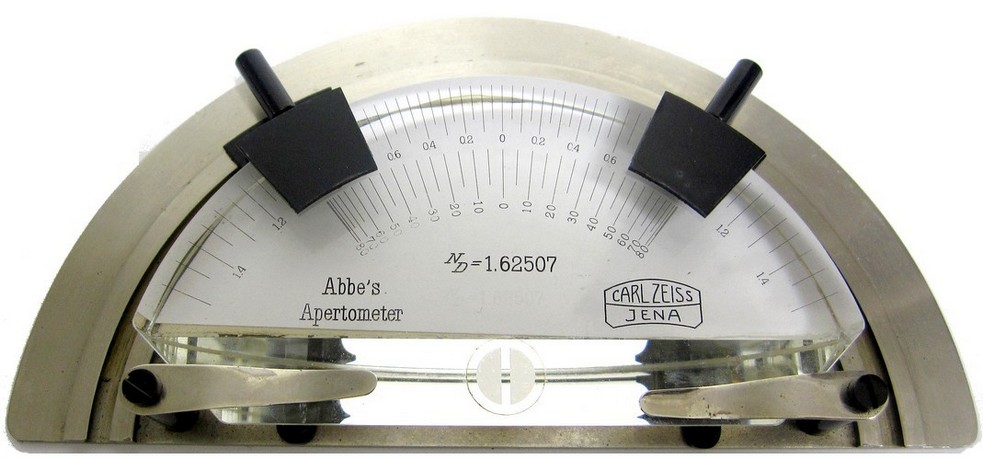
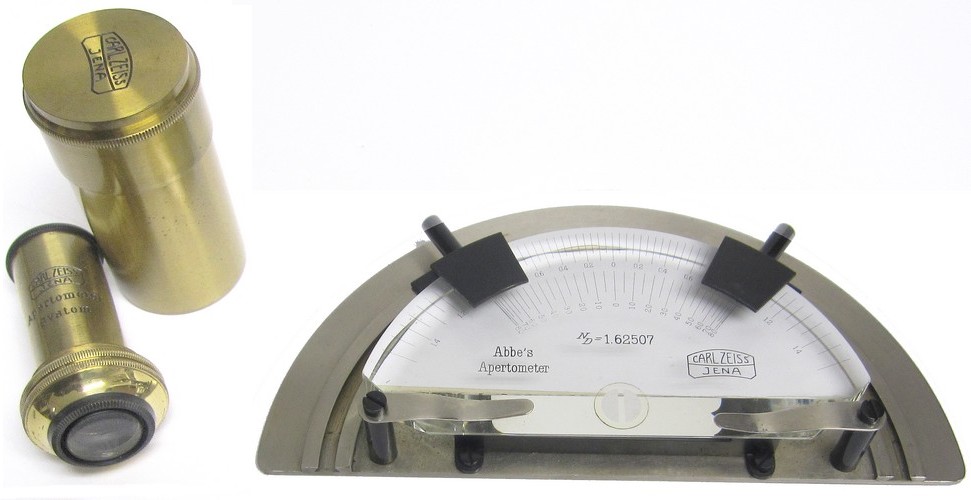
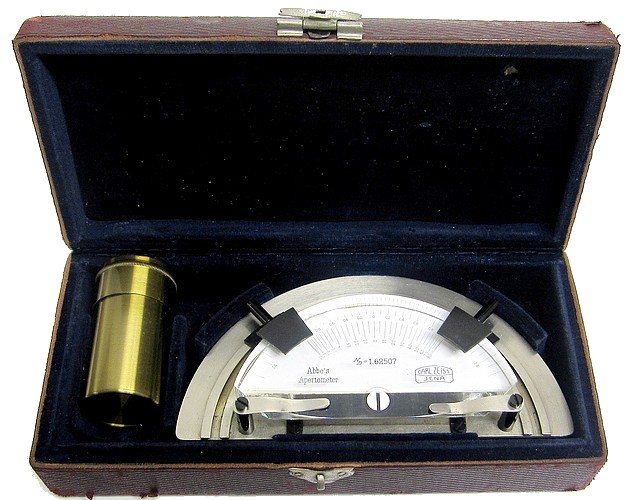
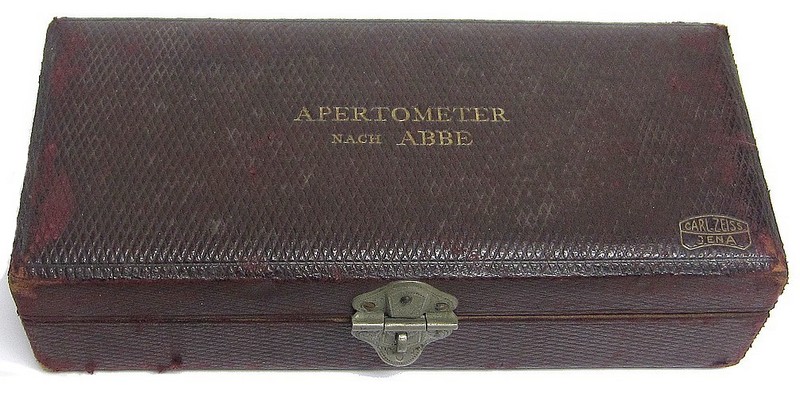
The following is extracted from the 1913 Zeiss catalog:.
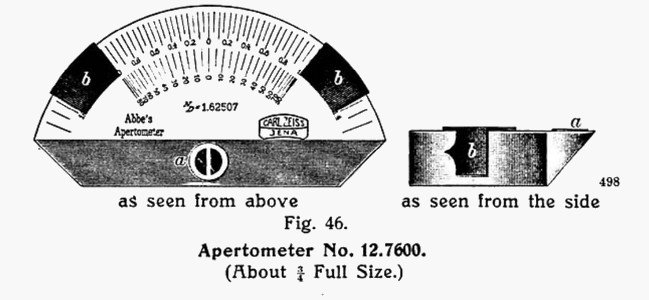
The Apertometer is a simple apparatus devised by ABBE in 1876 for determining the numerical and angular aperture of objectives. It can be used with any large or medium sized stand fitted with a draw-tube. The apparatus is supplied with a low power objective of about 40 mm focus which screws into the lower end of the draw-tube. The auxiliary microscope thus formed by the combination of this objective and the eyepiece having been focussed upon the exit pupil
of the objective
attached to the end of the tube proper, the aperture of the latter may be read off the rulings on the apertometer by means of two movable metal indices.
The theory of the apparatus and the method of measuring with it are explained in a paper by ABBE, Journ. Roy. Micr. Soc. (1), 1, 19—22, 1878, and (1), 3, 20—31, 1880; E. ABBE, Gesammelte Abhandl. I, 113—118, 1904, and 227—243; also DIPPEL, „Das Mikroskop“, I, 348—352. Directions of the use of the ABBE Apertometer, leaflet Mikro 114, are supplied with the instrument.
We supply two patterns of the Apertometer. In one of these (No. 12.7600) the indices move upon the glass plate without metal guides, whilst in the other (No. 12.7605) the glass slab is mounted upon a metal plate with a slot for the easier and more accurate displacement of the indices.

Directions for Use
(from the Mikro 114 leaflet supplied with the apertometer)
Place the Apertometer Plate, graduated side up upon the stage of the microscope and with the objective whose aperture is to be measured in conjunction with any eyepiece which happens to be at hand focus roughly the small slit in the circular disc of silver near the middle of the straight edge of the plate. In the event of the objective being of the immersion type the appropriate fluid should, of course, be introduced between the slit and the front lens. The
tube length should to that required for normal use of the objective.
Now place the two angular black metal cursors upon, and near the middle of the semicircular edge of the graduated plate, the pointers being on the cylindrical portion and the plain sides of the cursors on the flat face of the plate. When the objective has a rather high aperture, say 0.6 or more, the pointers should face outwards and away from each other, whilst with objectives of small aperture should face one another.
The set includes an auxiliary objective fitted with a diaphragm tube attachment. This should be screwed onto the screw thread at the lower end of the draw-tube, the diaphragm tube attachment being inside the latter. Into the other end of the draw-tube insert a Huygenian eyepiece, and, by sliding the draw-tube in or out within its collar, focus the auxiliary microscope so obtained with respect to the index points, an image of which appears in the
aperture of the primary
objective
Whilst sliding the draw-tube in or out care should be taken not to disturb the focusing adjustment of the objective attached to the main tube. To obviate this the latter should during the operation be firmly pressed with one hand against the supporting body frame or pillar of the microscope stand.
With high power objectives the preliminary adjustment with respect to the slit in the silver disk may be dispensed with and the auxiliary objective used at the outset. In this case to centre the apertometer plate, place the image of the slit as seen in the auxiliary microscope at the centre of the reflected image of the front lens of the objective and rack down the tube together with the objective until the visual field of the auxiliary microscope
attains its greatest
size, and finally focus the latter with respect to the images of the pointers.
Having made these adjustments displace the cursors along the circumference of the plate, making sure they may always lie snugly against the plate, until the extreme ends of the pointers just touch the periphery of the circle of light from within or without as the case may be. In the apertometers which are mounted upon a metal base the cursors move in circular slots, which keep them mechanically in close contact with the plate.
The mean of the two readings of the outer peripheral scale will the give by actual measurement the value of the numerical aperture of the objective in question. The mean of the readings furnished by the inner scale gives the value of the apertures in terms of the air angles.
To obtain a suitable illumination for use of the apertometer the light should be made to fall in a horizontal direction upon the cylindrical sides of the glass plate. In the event of the source of light not being wide enough to send sufficient light to both pointers so as to cause then to appear brightly illuminated at the same time, the difficulty may be overcome by placing in front of the microscope a semi-circular translucent screen, e.g. An appropriately
bent sheet of thin white paper. The upper edge of this screen should extend a little above the top of the apertometer.
The power of the eyepiece used on the auxiliary microscope should rise with the magnifying power of the objective under examination so as to obtain a sufficiently large image of the pointers etc., but on no account should an eyepiece be used the diaphragm of which partly cuts down the bright circle of light as seen through the auxiliary microscope.
To measure with the apertometer low apertures (less than 0.4 or 50 degrees) which are general associated with having foci of 7 mm and more, the pointer etc. Should be viewed with the unaided eye without the auxiliary microscope. To this end view the silver disk should be focussed, as described, and the eyepiece removed and replaced by a disc of cardboard or metal with a central hole, or by the centering stop supplied with stands 1C, D, and E. By
this mean the eye is kept in a contral position whilst looking towards the objective.
Between the last quarter of the 19th century and the first of the 20th, there were three version of the apertometer made. This is a example of the 2nd version. It differs
From the 1st in having a slit instead of a small hole on the silver disc. In the 1899 Zeiss catalog, it is evident that the first version was still being offered, but by the 1913 catalog, the 2nd version
was offered. The 1924 catalog shows the third form. Therefore, the apertometer shown here dates sometime after 1899, but before 1924.





